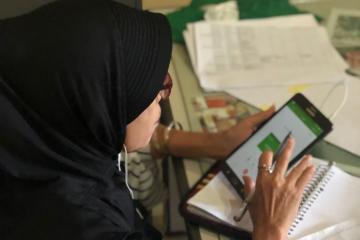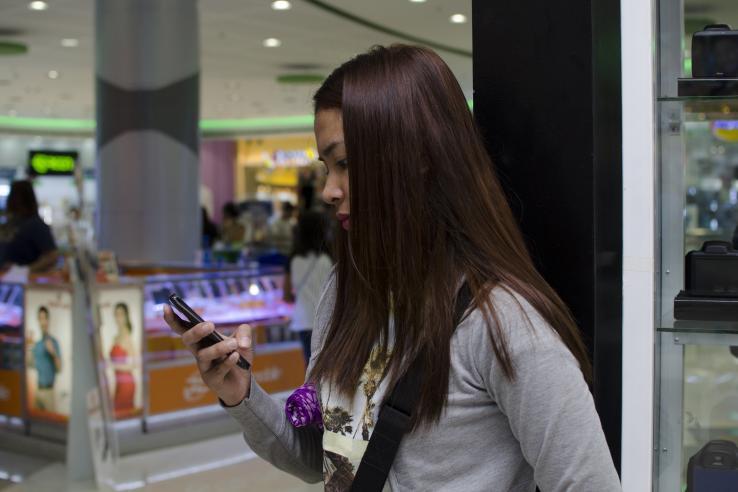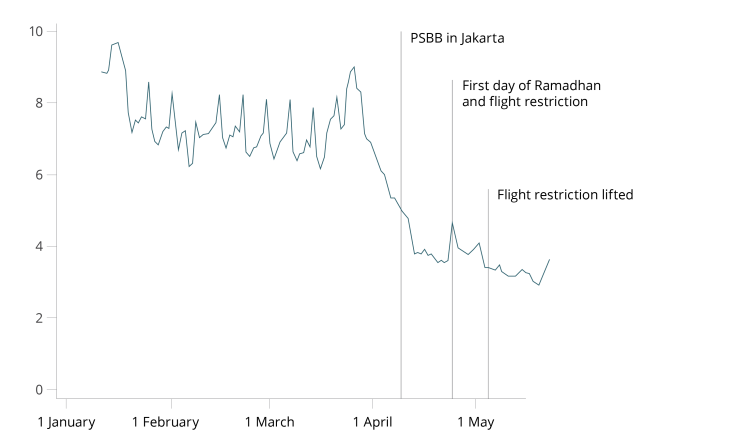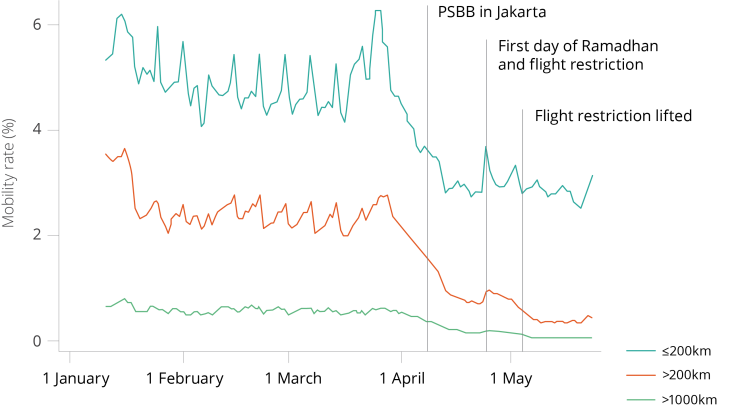
Using smartphones to trace mobility during regional lockdowns in Indonesia

Many policymakers are concerned about the costs of suspending economic activity due to COVID-19 lockdowns. Several have argued that enforcement of lockdowns will adversely affect the most vulnerable groups who do not have savings and rely on the informal sectors.
With this in mind, it’s useful to more clearly determine whether economic losses are caused by the enforcement of lockdowns, or rather by people’s own behavior in response to COVID-19. In other words, did people become less mobile as a result of the formal government-sanctioned lockdown, or as a result of the pandemic itself?
Indonesia provides a useful case study to answer this question, as lockdowns have been enacted in a decentralized and gradual way.
Several provinces adopted lockdowns or what was called "large-scale social restrictions" (Pembatasan Sosial Skala Besar, or PSBB) in Indonesia gradually by submitting requests to the Ministry of Health. For example, Jakarta applied for PSBB on April 2, and its PSBB was approved and started on April 10; while several other regions were initially rejected based on the number of cases in those areas.
To further manage the spread throughout Indonesia, long-distance train and air travel were also shut down at various dates in April, preventing Mudik, an annual tradition when millions of families travel to home villages near the end of Ramadan.
Using de-identified location data captured in smartphones obtained from the company Veraset, we worked with J-PAL Southeast Asia to study movement patterns to analyze how Indonesians changed their behaviors during the initial phases of COVID-19 and during the lockdown.
This data helps us understand mobility patterns, such as same-day commuting and inter-regional travel, as an indirect measure of economic activity—for example, commuting to the office, going shopping, and conducting trade activities.
Smartphone location data showed big changes in people’s mobility
The study found many smartphone users changed their behavior abruptly by reducing mobility when the number of COVID-19 cases begins to rise, followed by low and further decreasing mobility afterward. People made a one-time adjustment away from urban areas to other districts in late March, and the rate of inter-district travel remain small with a further decrease thereafter. Lastly, mobility was already low and changed little when the formal PSBB restrictions were implemented in Indonesia's major cities.
The analysis used location information from almost 60 million smartphone users in Indonesia for at least one point in time from January until May 2020. We restrict the sample to a smaller set of users who can be observed regularly during the timeframe.
This sample has some characteristics that may not reflect the larger population: Since the data only contains information from smartphone users, one could assume that they are likely to have a higher income than non-smartphone users. Migrant workers are 15 percentage points more likely to use smartphones than non-migrants who have the same level of household expenditure, so they are over-represented in this data. Nevertheless, in urban areas in Indonesia, smartphone use is already high. In the Jakarta capital region, it is 62 percent, 56 percent in predominantly urban districts, and 42 percent overall.


People stayed at home following the President's call to reduce COVID-19 transmission
To understand the changes in the rate of commuting and daily trips made by users, we measure same-day movement by comparing where users are during the night compared to daytime hours.
In January-February, before COVID-19 cases began to rise in Indonesia, the fraction of people staying home (defined as no travel beyond 200m away from nighttime location) on a given day ranges around 50 percent in Jakarta to 60 percent on average nationwide. After the President of Indonesia's speech on March 15 highlighting the urgency of COVID-19 and the call for social distancing, and as many other countries were introducing formal lockdowns, the fraction of people staying at home started to grow.
Two weeks later, the rate reaches around 80 percent and stays there until late May, at least. This is supported by the closing of schools and offices beginning to implement work-from-home policies. During national holidays, i.e., Indonesian Labor Day, Eid al-Fitr, the rate of people staying at home decreased further, with almost 90 percent of users remaining at home.
When the formal PSBB (lockdown) was introduced, Jakarta was the first region to implement the restriction on April 10, and the rate of mobility was already low. There was no noticeable jump in the number of people staying at home both in Jakarta and nationwide.
This suggests the changes in economic activity driven by smartphone users commuting to workplaces, traveling to shopping centers, or traveling for other purposes has already taken place, and were not a result of the formal lockdown.
People moved, then stayed, to adjust to lockdowns
We also looked at inter-district travel to understand changes in commuting and other daily economic and social activities, such as business travel, migrant workers traveling for work, and family travel. We analyzed medium- and long-distance travel between 500 districts in Indonesia by determining the median nighttime location for each user and defining that a user has moved if on a given night, they are found to be in a different district than two weeks prior.
At the start of the year, we observed a regular spike of weekend travel among users in and out of districts. After March 15, there is a large net outflow away from cities that lasts approximately two weeks. The travel flow then falls to around 50-75 percent compared to January-February.
The rate of travel remains low over the five months of observation, though an exception occurred at the start of Ramadan (concurrent with days leading to the ban of most internal passenger air travel). The small spike in travel happened in the context of "mudik," the Indonesia yearly return of migrants to their hometown at the end of Ramadan.
In anticipation of travel restrictions due to lockdowns, many migrant workers may have preemptively left large cities to avoid getting stuck. Due to the lack of nationwide lockdown and instead gradual regional restrictions, migrants who wanted to leave had the time to return to home regions.
Policy Takeaways
- Fear of COVID-19 played an essential role in the changes of people's mobility patterns. Results from this analysis show that people were sensitive to the information and recommendations provided by governments. Even without the formal lockdown of most economic activity, people could understand the urgency of the situation to limit the spread of the virus.
As countries begin to reopen its economy and adapt to the pandemic, it is worth noting that a false sense of familiarity with the virus may attenuate the initial fear despite the increasing rate of COVID-19 cases. This may further increase the COVID-19 trajectory of cases, leaving a share of the population from returning to their previous level of activity and impacting the economy. - Migrants anticipate formal restrictions that may trap them, and may travel due to the sudden decrease in job prospects in cities. However, after months of staying at home, many households may no longer be able to prioritize health concerns over their economic needs. This may be especially true for low-income workers who may be under-represented in our data.
- With or without active government lockdowns, the results strengthen the case for active government support to people affected by the economic disruption. Our analysis shows some economic loss driven by mobility is not necessarily led by formal government lockdowns and is influenced by how people react to the pandemic. To face the economic loss experienced by families indirectly caused by COVID-19, government should expand its social protection policies to reach vulnerable people as part of every country's COVID-19 strategy (Hanna and Olken in EPoD).
For more, see the original op-ed "Lockdown and Mobility in Indonesia" in the Centre for History and Economics.



